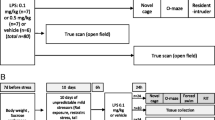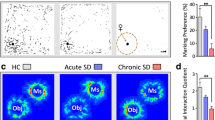Abstract
A significant proportion of patients suffering from major clinical depression exhibit sudden bursts of anger often described as “panic attacks without anxiety or fear” or “irritability.” We investigated aggressive behavior in mice from four different inbred strains subjected to unpredictable chronic mild stress (UCMS). Our results show that UCMS affects self-grooming behavior, as evaluated by the state of an animal's fur, with severity of symptoms differing according to genetic background. Furthermore, UCMS increased aggression both in a resident-intruder test and between cage-mates. UCMS is therefore a valuable model of the problematic aggressive behavior seen in depressive patients.
Similar content being viewed by others
References
Brezun, J. M., and Daszuta, A., (1999). Depletion in serotonin decreases neurogenesis in the dentate gyrus and the subventricular zone of adult rats. Neuroscience 89: 999-1002.
Brown, G. L., and Linnoila, M. I., (1990). CSF serotonin metabolite (5-HIAA) studies in depression, impulsivity, and violence. J. Clin. Psychiatry 51: 31-41; discussion 42–33.
de Almeida, R. M., Nikulina, E. M., Faccidomo, S., Fish, E. W., and Miczek, K. A., (2001). Zolmitriptan: A 5-HT1B/D agonist, alcohol, and aggression in mice. Psychopharmacology (Berl.), 157: 13l-141.
Ducottet, C., Griebel, G., and Belzung, C., (2003). Effects of the selective non-peptide corticotropin-releasing factor receptor 1 antagonist antalarmin in the chronic mild depression in mice. Prog. Neuro-Psychopharmacol. Biol. Psychiatry (in press).
Fava, M., and Rosenbaum, J. F., (1998). Anger attacks in depression. Depress. Anxiety 8: 59-63.
Fava, M., and Rosenbaum, J. F., (1999). Anger attacks in patients with depression. J. Clin. Psychiatry 60: 21-24.
Gass, P., Reichardt, H. M.,Strekalova, T., Henn, F., and Tronche, F., (2001). Mice with targeted mutations of glucocorticoid and mineralocorticoid receptors: Models for depression and anxiety? Physiol. Behav. 73: 811-825.
Griebel, G., Simiand, J., Serradeil-Le Gal, C., Wagnon, J., Pascal, M., Scatton, B., Maffrand, J. P., and Soubrie, P., (2002). Anxiolytic-and antidepressant-like effects of the non-peptide vasopressin V1b receptor antagonist, SSR149415, suggest an innovative approach for the treatment of stress-related disorders. Proc. Natl. Acad. Sci. USA 99: 6370-6375.
Guillot, P. V., and Chapouthier, G., (1996). Intermale aggression and dark/light preference in ten inbred mouse strains. Behav. Brain Res. 77: 211-213.
Guillot, P. V., Roubertoux, P. L., and Crusio, W. E., (1994). Hippocampal mossy fiber distributions and intermale aggression in seven inbred mouse strains. Brain Res. 660: 167-169.
Guillot, P. V., Sluyter, F., Crusio, W. E., and Chapouthier, G., (1999). Mice selected for differences in sensitivity to a benzodiazepine receptor inverse agonist vary in intermale aggression. Neurogenetics 2: 171-175.
Heidbreder, C. A., Weiss, I. C., Domeney, A. M., Pryce, C., Homberg, J., Hedou, G., Feldon, J., Moran, M. C., and Nelson, P. (2000). Behavioral, neurochemical and endocrinological characterization of the early social isolation syndrome. Neuroscience 100: 749-768.
Jacobs, B. L., Praag, H., and Gage, F. H., (2000). Adult brain neurogenesis and psychiatry: A novel theory of depression. Mol. Psychiatry 5: 262-269.
McEwen, B. S., (2001). Plasticity of the hippocampus: Adaptation to chronic stress and allostatic load. Ann. NY Acad. Sci. 933: 265-277.
Michard, C., and Carlier, M., (1985). Les conduites d'agression intraspécifique chez la souris domestique: Différences individuelles et analyses génétiques. Biol. Behav. 10: 123-146.
Nelson, R. J., and Chiavegatto, S., (2001). Molecular basis of aggression. Trends Neurosci. 24: 713-719.
Porsolt, R. D., (2000). Animal models of depression: Utility for transgenic research. Rev. Neurosci. 11: 53-58.
Sapolsky, R. M., (2000). Glucocorticoids and hippocampal atrophy in neuropsychiatric disorders. Arch. Gen. Psychiatry 57: 925-935.
SAS Institute, Inc. (1987). SAS/STAT Guide for Personal Computers, Version 6 Edition. Cary, NC: SAS Institute.
Scott, J. P. (1958). Aggression. Chicago, IL: The University of Chicago Press.
Sluyter, F., Jamot, L., van Oortmerssen, G. A., and Crusio, W. E., (1994). Hippocampal mossy fiber distributions in mice selected for aggression. Brain Res. 646: 145-148.
Tannenbaum, B., and Anisman, H., (2003). Impact of chronic intermittent challenges in stressor-susceptible and resilient strains of mice. Biol. Psychiatry 53: 292-303.
Tannenbaum, B., Tannenbaum, G. S.,Sudom, K., and Anisman, H., (2002). Neurochemical and behavioral alterations elicited by a chronic intermittent stressor regimen: Implications for allostatic load. Brain Res. 953: 82-92.
van Riel, E., Meijer, O. C., Veenemal, A. H., and Joels, M., (2002). Hippocampal serotonin responses in short and long attack latency mice. J. Neuroendocrinol. 14: 234-239.
Willner, P., (1997). Validity, reliability and utility of the chronic mild stress model of depression: A 10-year review and evaluation. Psychopharmacology (Berl.) 134: 319-329.
Young, S. N., and Leyton, M., (2002). The role of serotonin in human mood and social interaction: Insight from altered tryptophan levels. Pharmacol. Biochem. Behav. 71: 857-865.
Rights and permissions
About this article
Cite this article
Mineur, Y.S., Prasol, D.J., Belzung, C. et al. Agonistic Behavior and Unpredictable Chronic Mild Stress in Mice. Behav Genet 33, 513–519 (2003). https://doi.org/10.1023/A:1025770616068
Issue Date:
DOI: https://doi.org/10.1023/A:1025770616068




